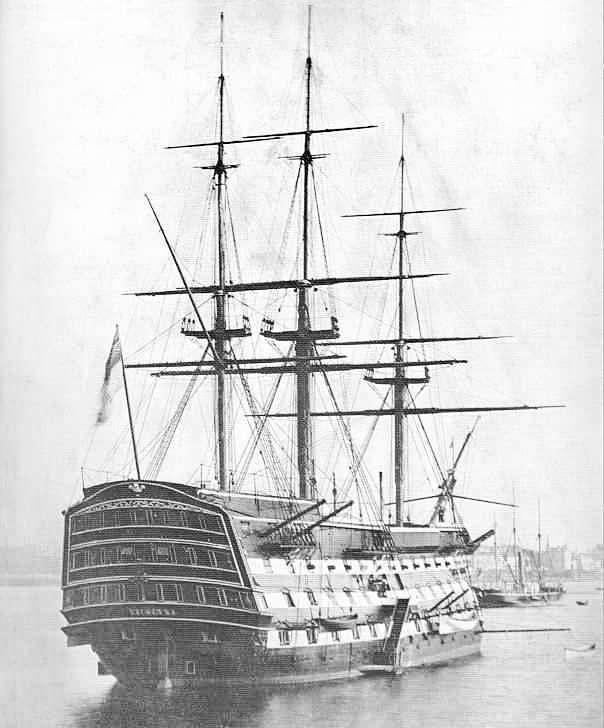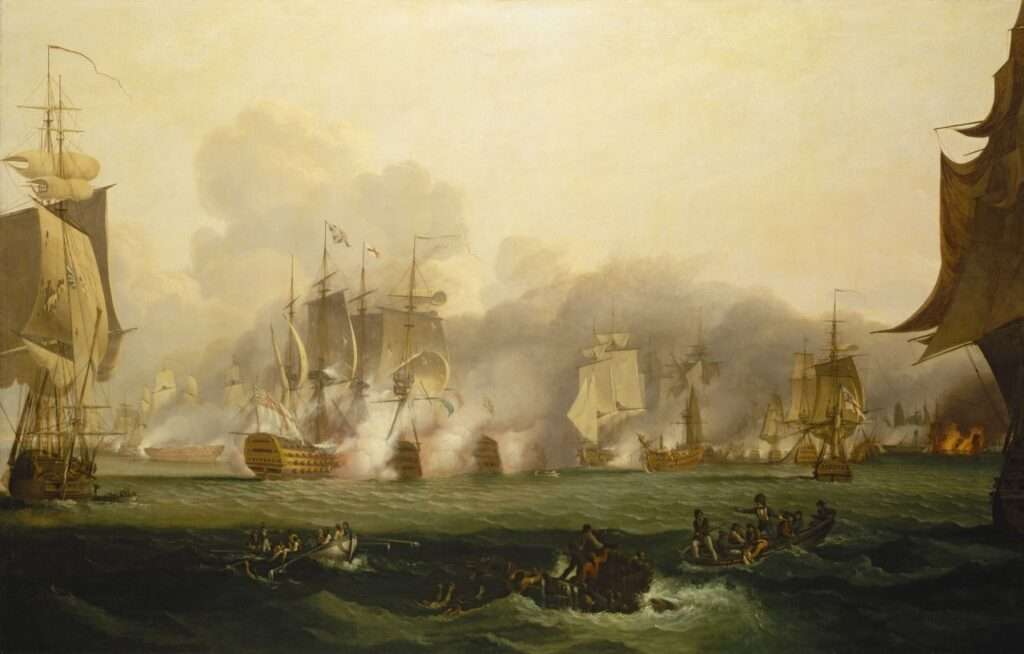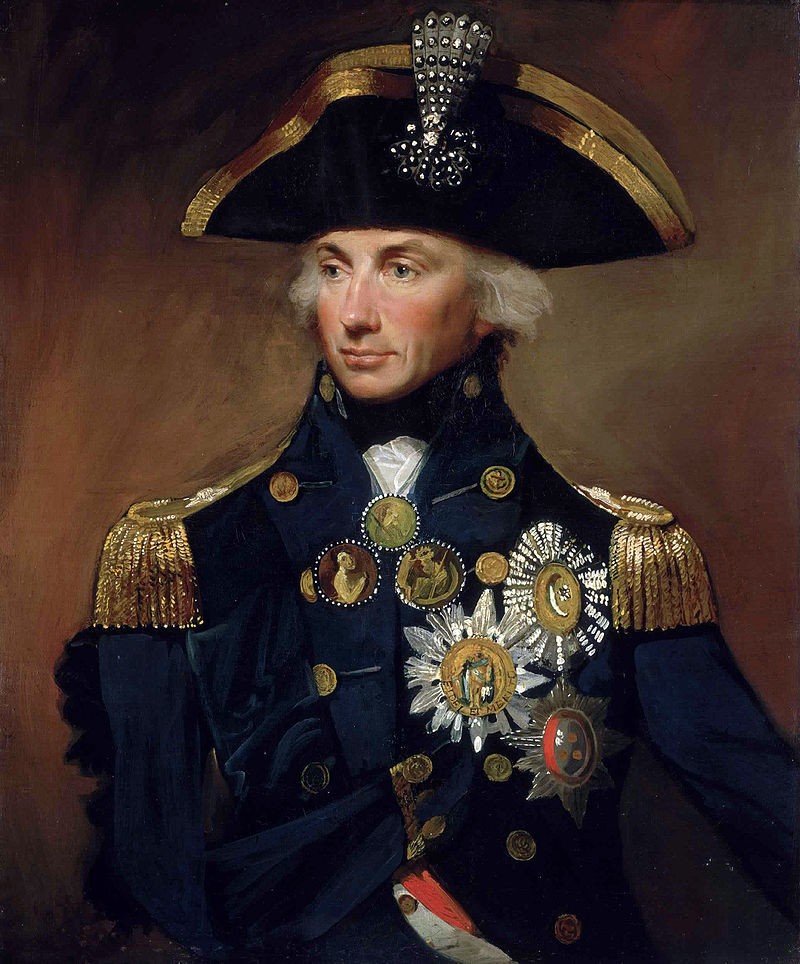Horatio Nelson and HMS Victory are two of the most iconic symbols of naval history.

Nelson, one of the most famous and revered naval commanders of all time, is known for his decisive victories at the Battle of the Nile, the Battle of Copenhagen, and the Battle of Trafalgar, among others.
Victory, meanwhile, is the ship that carried Nelson to many of his greatest triumphs, including his final battle, and has become a symbol of British naval might and resilience.
Here we’ll explore the history of both Nelson and HMS Victory, focusing on where the ship was built, when it was launched, and the battle of Trafalgar and Nelson’s death.
HMS Victory
HMS Victory was built at Chatham Dockyard in Kent, England, between 1759 and 1765.
The ship was designed by Sir Thomas Slade, who was a respected naval architect. He had already designed several successful warships for the Royal Navy.
Victory was an impressive vessel, measuring 227 feet in length and weighing over 3,500 tons.
It was constructed from over 2,000 oak trees, which were felled from the forests of Kent, Sussex, and Hampshire.
The ship’s design featured three gun decks and 104 gun. This made it one of the most powerful warships of its time.
 HMS Victory at the first Battle of Ushant (1778).
HMS Victory at the first Battle of Ushant (1778).
On May 7, 1765, Victory was launched and began its career as a warship for the Royal Navy.
However, it was not until 1778 that the ship was commissioned for active service. It had spent most of its early years in dock undergoing repairs and modifications.
When it finally went to sea, Victory quickly proved to be a formidable vessel.
Its design allowed it to sail faster than many smaller ships. Its powerful armament made it a fearsome opponent in battle.
Firepower
HMS Victory, like many other ships of its time, was equipped with a large number of cannons.
These cannons were the primary weapons of naval warfare during the 18th and early 19th centuries.
They were used to fire heavy iron balls at enemy ships in order to damage their hulls, masts, and rigging.
The lower gun deck was home to 30 32-pounder cannons, which were the heaviest guns on the ship.
These cannons weighed over two tons each and fired iron balls that weighed 32 pounds.
The middle gun deck was home to 28 24-pounder cannons, which were slightly lighter than the 32-pounders but still very powerful.
The upper gun deck was home to thirty 12-pounder cannons.
Although these were lighter still but very useful for firing at the upper decks of enemy ships.
In addition, the Victory had eight 68-pounder carronades, which were short-barrelled guns that fired heavy shot at close range.
 The starboard side of HMS Victory showing her mighty firepower.
The starboard side of HMS Victory showing her mighty firepower.
The cannons on the Victory were manned by large teams of sailors.
The sailors had to load and fire the guns quickly and accurately during battle.
Each cannon required a crew of several sailors, including a gun captain, who was responsible for aiming and firing the gun, and several gunners, who loaded the gun and cleaned it between shots.
In addition, there were several other gun crew members. These included powder monkeys, who carried gunpowder from the magazine to the guns, and carpenters, who repaired the gun carriages and other equipment.
The Victory itself was hit many times during the battle, and several of its guns were disabled. Despite this the crew continued to fight on using the remaining guns and other weapons.
French Revolutionary Wars
In 1793, Victory was recommissioned as the flagship of Vice-Admiral Lord Hood and sent to the Mediterranean to participate in the French Revolutionary Wars. The ship played a key role in the Siege of Toulon.
It was here it became part of an Anglo-Spanish fleet that was eventually forced to surrender the French port to Napoleon’s forces.
It also took part in the siege of Calvi in Corsica in 1794, where it helped to oust the French from the island.
In 1797, Victory became the flagship of the new commander-in-chief, Sir John Jervis.
Under Jervis, the ship was present at the Battle of Cape St Vincent on February 14, 1797.
 HMS Victory in Portsmouth Harbour before her move into a dry dock.
HMS Victory in Portsmouth Harbour before her move into a dry dock.
In the opening stages of the battle, Victory played a key role, helping to break through the Spanish line of battle and inflict heavy losses on the enemy.
However, Victory was badly damaged in the battle. It was sent back to Britain at the end of 1797 to undergo repairs and refitting.
After another refit in 1803, Victory was assigned to Horatio Nelson, who was by then a celebrated naval hero. Nelson had already achieved significant victories in the Napoleonic Wars, including the Battle of the Nile in 1798 and the Battle of Copenhagen in 1801.
However, his most famous and final battle would be fought aboard Victory at Trafalgar.
The Battle of Trafalgar
The Battle of Trafalgar was the most famous engagement of HMS Victory.
It was also the most significant naval battle of the Napoleonic Wars. The battle was fought on October 21, 1805, off the coast of southwestern Spain.
It was here the British Royal Navy and the combined fleets of France and Spain clashed.
The British fleet, commanded by Admiral Lord Nelson aboard HMS Victory, won a decisive victory. Sadly Nelson was mortally wounded during the battle.
HMS Victory played a crucial role in the battle, as the flagship of the British fleet. She was one of 27 British ships that engaged the combined French and Spanish fleet, which consisted of 33 ships of the line and a number of smaller vessels.
The battle began in the morning, with the British fleet led by HMS Victory approaching the enemy in two columns.
Nelson’s famous signal, “England expects that every man will do his duty,” was hoisted aboard Victory, and soon the two fleets were engaged in fierce combat.
 The ferocity of the Battle of Trafalgar can clearly be seen in this 1825 painting of HMS Victory.
The ferocity of the Battle of Trafalgar can clearly be seen in this 1825 painting of HMS Victory.
HMS Victory was heavily engaged in the battle, exchanging fire with the French ship Bucentaure, which was the flagship of Admiral Pierre-Charles Villeneuve, commander of the French and Spanish fleet.
Victory pounded the Bucentaure with broadsides, while also fending off attacks from other enemy ships. Nelson himself was on deck, directing the action and encouraging his men.
During the battle, he was hit by a musket ball fired from the mizzen-top of the French ship Redoubtable, and suffered a fatal wound to his spine.
The Death of Nelson
Despite the loss of their commander, the British fleet continued to fight fiercely.
Victory continued to engage the Bucentaure, and eventually the French ship surrendered.
Victory then turned her guns on the Redoutable, which was also engaged with other British ships.
Victory’s fire, combined with that of the other British ships, eventually forced the Redoutable to surrender as well.
Victory also engaged the Spanish ship Santisima Trinidad, the largest ship in the enemy fleet, and inflicted heavy damage on her.
 Vice Admiral Horatio, Lord Nelson. The most famous sailor of them all.
Vice Admiral Horatio, Lord Nelson. The most famous sailor of them all.
In the end, the British fleet won a decisive victory, with 22 of the enemy ships captured or destroyed.
Victory had suffered heavy damage in the battle, with her masts and rigging severely damaged, and 57 of her crew killed and 102 wounded.
But she had played a crucial role in the victory, and had demonstrated the power and effectiveness of the Royal Navy.
The Battle of Trafalgar was a turning point in the Napoleonic Wars, and ensured British naval supremacy for decades to come.
It was also a great personal triumph for Lord Nelson, who had long been a hero to the British people.
His death in the battle, aboard HMS Victory, made him a legend, and ensured the ship’s place in history.
Today, HMS Victory is one of the most famous and revered ships in the world, and a symbol of British naval power and heroism.
Legacy
Today, the Victory is preserved as a museum ship in Portsmouth, England, and is one of the most popular tourist attractions in the country.
Visitors can tour the ship and see the very spot where Nelson fell during the Battle of Trafalgar.
The Victory is also still considered a commissioned ship in the Royal Navy, and it is the flagship of the First Sea Lord, the professional head of the Royal Navy.
In conclusion, HMS Victory is one of the most famous and important ships in British history.
Built in 1759 and launched in 1765, it played a key role in many of the most significant naval battles of the 18th and early 19th centuries, including the Battle of Trafalgar, where it served as Admiral Nelson’s flagship.
Despite being badly damaged in the battle, the Victory survived and went on to serve in the Royal Navy for many more years. Today, it is preserved as a museum ship.